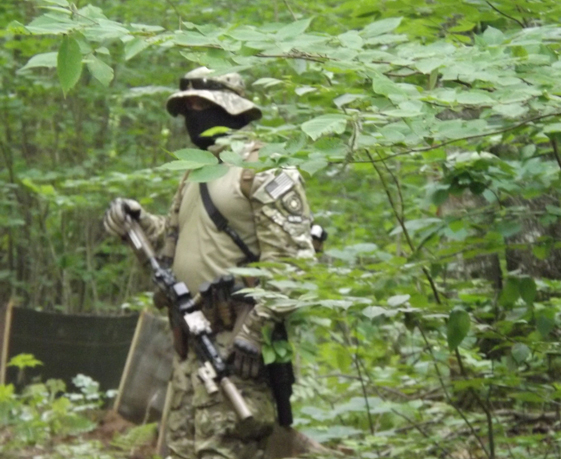A picture, they say, is worth a thousand words. There was a time when rhetorical studies may not have heeded the old maxim, but following the work of Lucaites and Hariman, Finnegan, and countless others over the years, image rhetoric has become an increasingly rich focus of attention—especially in a digital age when more and more folks get their news in ten second chunks of tweets, links, and screen caps and when digital cameras upload instant reports from the cell phones of tens of thousands of people every day.
In the ongoing debate over iron-ore mining in Wisconsin’s Penokee Hills—a debate to which politicians and PR firms, tribal leaders and grass roots ecologists have all added a thousand words or so —a simple handheld camera has become a central figure, swaying public opinion in multiple directions.
Mining operations in the Penokees, along the Gogebic Iron Range, have stirred controversy from the moment they were first proposed. Gogebic Taconite, LLC, the Florida-based company currently testing the range and potentially developing the largest mine in the state of Wisconsin, has fallen under harsh criticism from the towns and tribes surrounding the site, along with several Democratic state politicians and ecologists. All are concerned that the mine will damage fragile ecosystems, infringe on public use of the nearby land, and harm waterways with acid drainage.
These protests did little to sway public opinion, though, or to halt the progress of the mine’s development. Gogebic Taconite moved forward with initial testing and desperate opponents of the mine flocked to the Penokee Hills to demonstrate and disrupt operations. Those sympathetic to the mine saw the demonstrators as hippies and hooligans. Those sympathetic to the protests struggled to sway opinion in a broader, largely indifferent or undecided public.
Then, in early July, an image hit the airwaves, taken by a visitor to the woods around the testing site. Gogebic Taconite had hired out the services of the Arizona-based private security firm Bulletproof to protect its workers and equipment from unruly protestors and protestors had, in return, captured one of these guards on camera. In a stretch of state-owned land previously open to public use, the image showed a camouflaged man, with his face partially covered and toting an assault rifle. The Bulletproof agent looked more like a special ops solider than a security guard in a publicly accessible place. Suddenly, the opposition to the mine had an opportunity.
The image of the soldier acted as an image vernacular—a visual enthymeme—for those who saw it on their television and computer screens. The striking figure, like something out of a Hollywood movie, played well on the evening news as it garnered more immediate attention than long-winded reports about the complexities of geological survey. This G.I. Joe, this skulking guerilla, found camouflaged and hidden in the simple Wisconsin woods made Gogebic Taconite’s actions seem aggressive and hyperbolic. It was scary for many to see the image and imagine that they, too, might be stalked by a trained soldier with an assault rifle the next time they took a walk in the forest. Suddenly, those indifferent and undecided audiences had a reason to be suspicious of the mine and its motives.
Initially, Gogebic Taconite defended its actions and claimed the Bulletproof guards would remain. However, as the image replayed on TV and computer screens and more and more voices—like that of Democratic Senator Bob Jauch—cried out that the Upper Midwest was no place for mercenaries, the guards were removed. The Arizona-based firm, it turned out, did not actually have a license for such operations.
Now, several months later, the license has been acquired and Gogebic Taconite has announced, to little fanfare, that the Bulletproof guards will eventually return at an undisclosed date. Still, the image has done its work and many more Wisconsinites are both aware of and suspicious of the mining activities now taking place just beyond their backyards.
For many, the mine is now synonymous with aggression, violence, and fear. It’s interesting then, that the images of the protestors have garnered less attention. That is, while the camouflaged soldier appeared around the state, few ever saw the images of the masked and rowdy protestors who first disrupted mining operations and supposedly prompted the Bulletproof hiring in the first place. On June 11, a group of militant protestors filmed themselves rushing a test site, screaming profanities and forcefully seizing one Gogebic Taconite employee’s phone and camera. The protestors were wrapped also like guerillas or freedom fighters, with their faces hidden, and, though unarmed, were unruly and aggressive in their conduct. Those who forwarded the video on conservative websites often described the protestors as “eco-terrorists,” and the conduct and dress of the protestors in the video make such terms and comparisons understandable. The incident led to a felony charge for one protestor, but the video got less public media play, perhaps because of the profanity used and its six-minute length.
As in all such cases, there is not a simple black and white, good and bad dichotomy to be made. Yet many now fear that the tension in the Penokees is still only building, and these images of armed and masked individuals are making the stakes seem more desperate from both sides of the issue. These violent images, reminiscent of scenes from a war zone, are causing the two sides in the debate to feel and self-identify more as two sides in a war. The debate will certainly continue, but the debaters are no longer armed only with their words.



